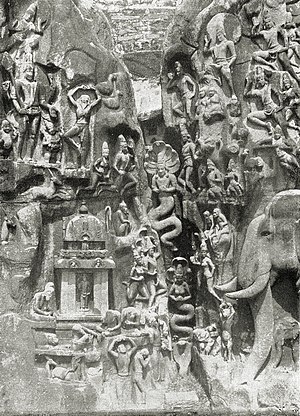Suryavansha

The Sooryavamsham or Suryavansh or Suryavamsa or Sun Dynasty or Solar Dynasty (Sūrya-vaṃśa) was one of the most prominent[peacock prose] dynasties[when defined as?] in the history of India[chronology citation needed], along with the "Chandra-vaṃśa" or Lunar Dynasty.
Introduction
The term Suryavanshi refers to a person belonging to the Suryvansha dynasty. This clan was the oldest and biggest Kshatriya clan of India which was also known by many synonyms as Adityavamsha (आदित्यवंश), Mitrawamsha (मित्रवंश), Arkawamsha (अर्कवंश), Raviwamsha (रविवंश), etc. The early Suryavanshis considered Sun-god ('Surya', 'Aditya' or 'Arka') as their kul-devta (clan God) and mainly practised sun-worship.The capital of Solar race was ancient Ayodhya.The clan founder, Vivasvan or Vaivaswat Manu, also known as Arka-tanaya (अर्क तनय) or son of Arka (Surya), is supposed to have lived coeval with the origin of the world.[dubious – discuss][citation needed] The name Vivaswan literally means master of the rays, i.e. the Sun or Sun God. The first historically important king of this dynasty was Vivaswan's grandson Ikshvaku, so the dynasty is also known as the Ikshvaku dynasty.
The last important king of Ayodhya was Brihdbal, who was killed by Abhimanyu in the Kurukshetra war. The last ruling king of the dynasty at Ayodhya was Sumitra in the 4th century BC, who, after being forced out of Ayodhya by emperor Mahapadma Nanda of Magadha's Nanda Dynasty, continued the royal line at [[RohtasHistorically, the Suryawanshis were Sun-worshipers and are described as devoted to the feet of the Sun-god (God Surya). The copper-plate grants of Suryawanshis bear an emblem of the Sun and on their seals too, this symbol is depicted.[1]
As laid down by Manu, the kings of the Solar dynasty followed the rule of primogeniture. Only the eldest male offspring of the king could succeed to the throne, unless disqualified by the priests for being physically disabled or some other reason. The younger sons also produced many prominent historical Kshatriyas and Vaishyas, but these are not included in the following list of monarchs. The list, however, does include some rightful heirs who were disqualified by the priests.[citation needed]
Source of the lineage

The Puranas, particularly Vishnu Purana, Ramayana by Valmiki and the Mahabharata by Vyasa gives accounts of this dynasty. The Raghuvamsha of Kalidasa also mentions the names of some of the kings of this dynasty.[2][3][4]
References
- ^ Lālatā Prasāda Pāṇḍeya (1971). Sun-worship in ancient India. Motilal Banarasidass. p. 245.
- ^ Pargiter, F.E. (1922). Ancient Indian Historical Tradition. Oxford University Press. pp. 90–91.
- ^ Ramakatha Rasavahini. Prasanthi Nilayam: Sri Sathya Sai Books and Publications Trust. 2002. ISBN 8172081324.
{{cite book}}:|first=missing|last=(help) - ^ The Ramayana. New Delhi: Penguin Books. 1996. ISBN 0140298665.
{{cite book}}:|first=missing|last=(help)CS1 maint: multiple names: authors list (link)
